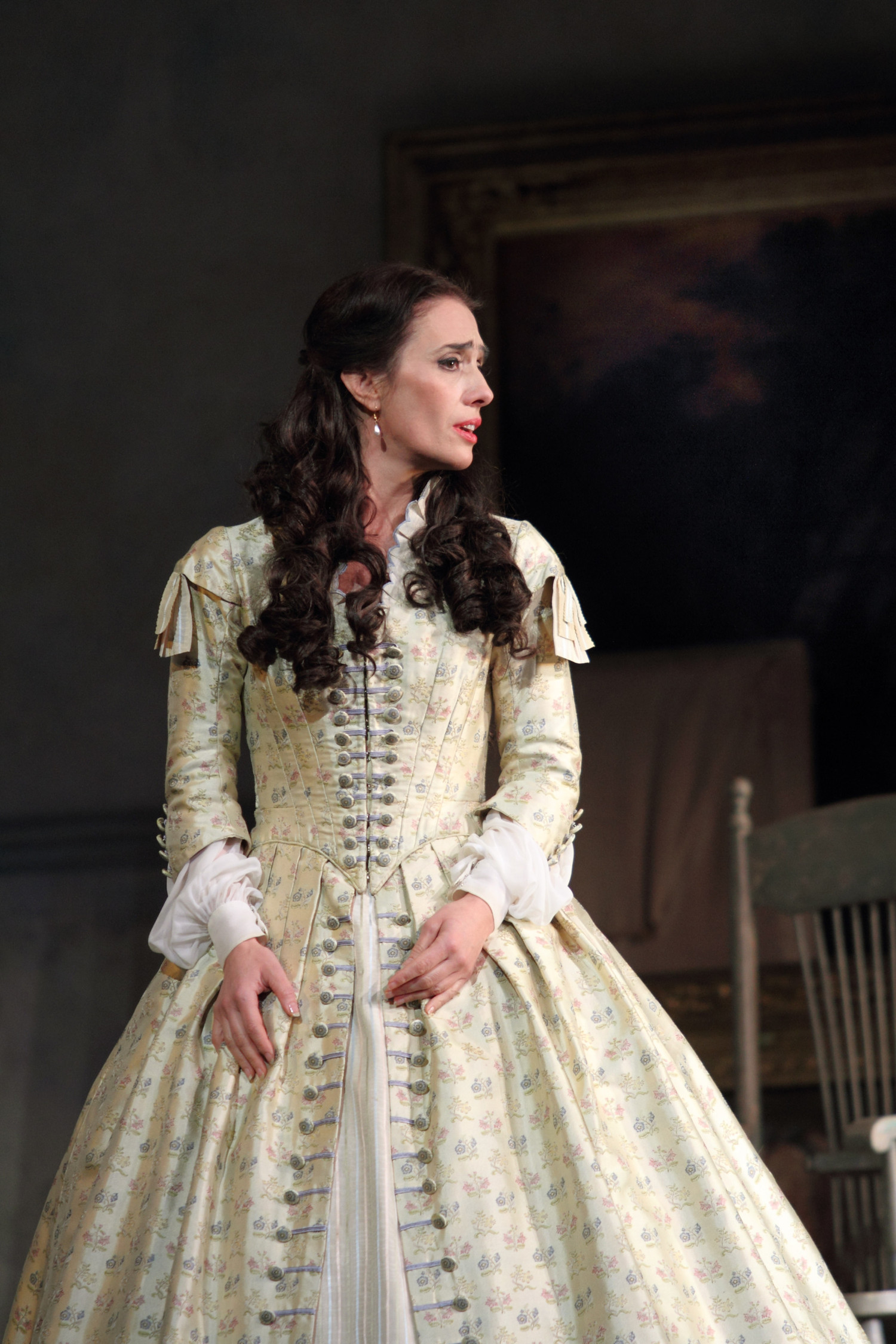Review: LA TRAVIATA, Royal Opera House

![]() Enrobed in luminous gold taffeta, velvet and silk, Richard Eyre's 1994 production of La traviata is decorous yet quintessentially simple. Elegant and functional, in a sartorial context it's the little black dress among evening gowns.
Enrobed in luminous gold taffeta, velvet and silk, Richard Eyre's 1994 production of La traviata is decorous yet quintessentially simple. Elegant and functional, in a sartorial context it's the little black dress among evening gowns.
Housing the hedonistic Violetta in a golden dome with salon guests attired in a motley gallery of matching shades, most scenes explore a single colour palette to reflect the social ambience and Violetta's inner self - both psychologically and physically.
In that regard, while the production's lacquered sets comprise a non-conceptual, traditional version of the tale, closer scrutiny allows the audience to eye a fine collation of small details: the coordinated assortment of red and black stripes, sequins and squares across the crinoline-held dresses of the gypsy girls; red velvet chairs and walls behind them signalling impending sin around the gambling table; Violetta wearing a turtleneck black dress of mourning to the party after leaving Alfredo and its contrast to her previous décolleté gown.
While certain facets of the spectacle can overdo its exposition of the plot - Alfredo and Violetta's removed paintings symbolising poverty; carnival-goers' wall-sized shadows looming high over the walls of dying Violetta's apartment - for the most part the 25-year-old production remains durable.
Studious in her approach to Violetta, Ermonela Jaho's supple soprano twirls coloratura with the ease of swaying ribbon over a maypole. Flexing a moderately sized instrument that resounds with a piquant, throbbing vibrato, Jaho's slender, birdsong style of voice is comparable to the endearing timbre of a piccolo.
Though this restricts to some extent the vocal force she lends crescendo climaxes like Violetta's potent declaration "Amami Alfredo" ("Love me, Alfredo"), it doesn't limit her superlative agility and largely undeniable technique. The complex "Sempre libera" coloratura is executed delicately and smoothly throughout, and other difficult moments such as Violetta's insistence that she would rather die rather than leave her beloved ("Preferirò morir!") are ardently embarked on and fortified with zeal to the end.
Particularly salient is Jaho's use of chest voice as she effortlessly morphs her instrument into another creature through the lowest notes with such commands as "Silenzio - va all'istante" ("Silence - go at once") to her maid.
Artistically, Jaho's propensity to collapse certain tender diminuendi into whispers comes off as slightly affected. Yet for the most part it's a delight to listen to the singer carefully proportion note lengths, rhythms and dynamics to explore her character's cracking veneer, aggressive illness and blind generosity.
Charles Castronovo is indefatigable in his interpretation of Alfredo - albeit not always to his benefit. Assuming most phrases with a relentless degree of panache, he portrays the naïve character as a self-satisfied, somewhat audacious fledgling.
With a full-bodied tenor and mostly solid technique, Castronovo strays from sentimental diminuendi and unpretentious expressions of feeling - so much so that by the time his character is desperately attempting to persuade consumption-ridden Violetta she will live so they can build a new life far away in greener pastures with "Parigi, o cara," he continues to sound stubbornly emboldened.
Emphasising Violetta's fragile condition to his father, "La vedi, padre mio?" ("Do you see her, father?") Castronovo not only faces the audience - but walks downstage and not towards Germont.
Despite likewise possessing an indisputably corporeal instrument, bass Igor Golovatenko performs the occasionally ambiguous character of Germont with a mostly homogeneous voice and array of inflections.
While certain basses have portrayed Germont either sympathetically or sinisterly as he persuades dying Violetta to abandon her lover for the sake of their family's reputation, Golovatenko avoids swinging to either extreme, settling instead for a patriarchal, headmaster-like middle.
In phrases whose subtext are tantalisingly questionable - such as "Bella, voi siete, e giovine" ("You are beautiful, and young") in which Germont tries to persuade Violetta that both she and Alfredo will forget their liaison in time, the bass remains fairly emotionless - effectively subtracting from what could have been a more incisive reading of the character.
Making his Royal Opera House debut, conductor Antonello Manacorda assumes a classical, almost baroque interpretation of the opera's score. With indisputably precise but unexciting rhythms, Manacorda reduces the conventional use of Italian operatic rubato, preferring to drive certain chords - such as the anxious staccato triad after Violetta starts disclosing her consumption to Germont ("Non sapete... quale affetto") - with the trenchant abruptness that could come from a Beethoven symphony.
Despite preserving moderate dynamics, Manacorda's strings whip up tempestuousness with ease. The result is an approach that's novel and intriguing even if it be an accidental one.
While the performance suffers somewhat from insufficient spice and dwindling vigour, its aged material backdrop remains irreproachable. Like an old rug that needs a beating to eject the choking dust out of its furry spikes, the production can survive more rounds in the same habitat - as long as it's endowed with an enlivened cast.
La traviata runs at the Royal Opera House until 31 January.
Photo credit: Catherine Ashmore
Videos
